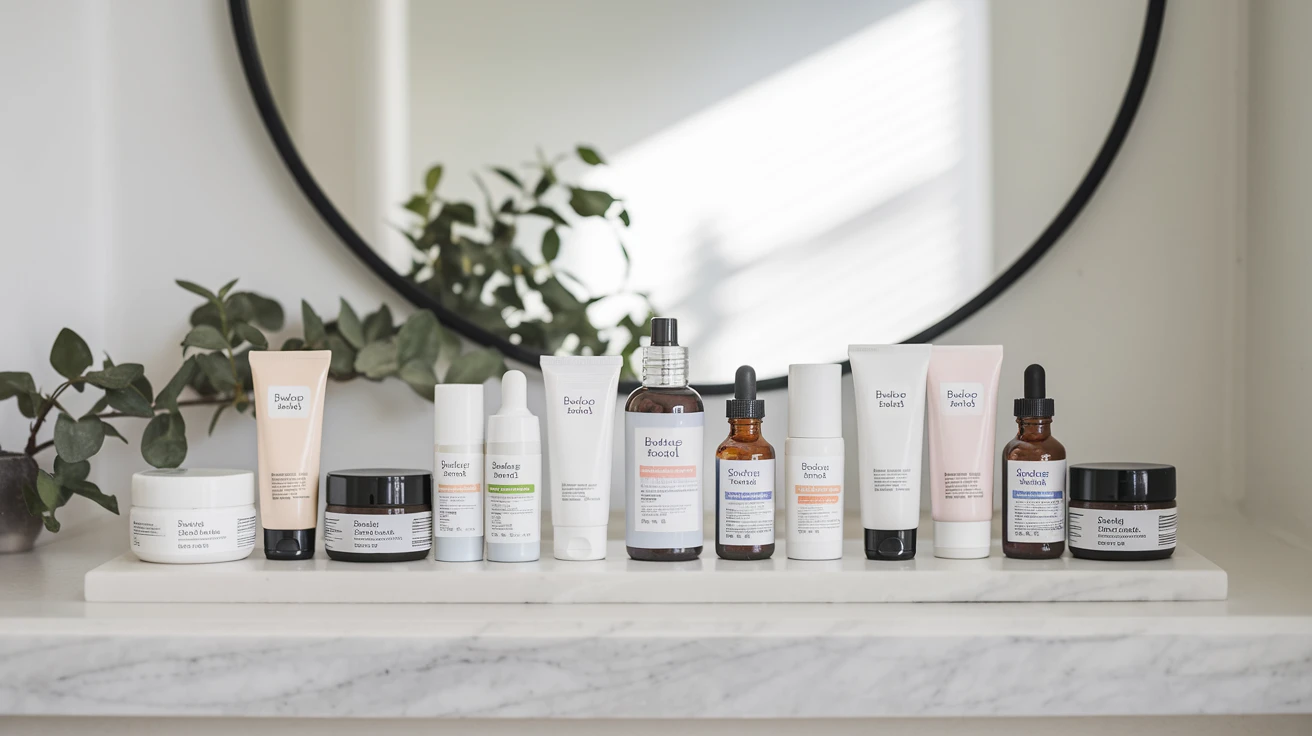
The Ultimate Guide to Daily Skin Care Routines
A well-crafted daily skin care routine isn’t just a luxury—it’s essential for maintaining healthy, radiant skin throughout your life. Whether you’re dealing with oiliness, dryness, sensitivity, or the first signs of aging, having a consistent approach to skin care can transform your complexion. In this comprehensive guide, I’ll walk you through five customized daily skin care routines designed for different skin types and concerns.
The beauty of these routines is their adaptability. As someone who’s experimented with countless products and regimens over the years, I’ve learned that the best daily skin care routine is one that you’ll actually stick with. Each of these routines can be tweaked to suit your specific needs, schedule, and budget.
- Each routine follows a basic structure that can be customized
- Products can be swapped based on preference and availability
- Consistency matters more than using expensive products
- Your skin’s needs may change with seasons, hormones, and age
Understanding Your Skin Type: The Foundation of Your Daily Skin Care Routine

Before diving into specific routines, it’s crucial to identify your skin type. This knowledge forms the foundation of an effective daily skin care routine. I spent years using products that weren’t right for my combination skin, which only exacerbated my concerns instead of addressing them.
- Oily skin: Appears shiny, especially in the T-zone, with enlarged pores and prone to blackheads and breakouts
- Dry skin: Feels tight, may have flaky patches, fine lines are more visible, and can be rough in texture
- Sensitive skin: Reacts easily to products, may become red, itchy, or irritated, and can sting or burn with certain ingredients
- Combination skin: Features an oily T-zone with drier cheeks and can show characteristics of multiple skin types
- Aging skin: Shows fine lines, wrinkles, loss of elasticity, and may have increased dryness or hyperpigmentation
Not sure about your skin type? Try the blotting paper test: after cleansing, wait an hour and press blotting paper to different areas of your face. The amount of oil absorbed will help identify your skin type. Remember, your skin type can also change with seasons, hormones, and age.
Pro tip: If you’re still uncertain about your skin type, consider consulting with a dermatologist who can provide a professional assessment and personalized recommendations for your daily skin care routine.
1. Daily Skin Care Routine for Oily Skin: Balance and Control
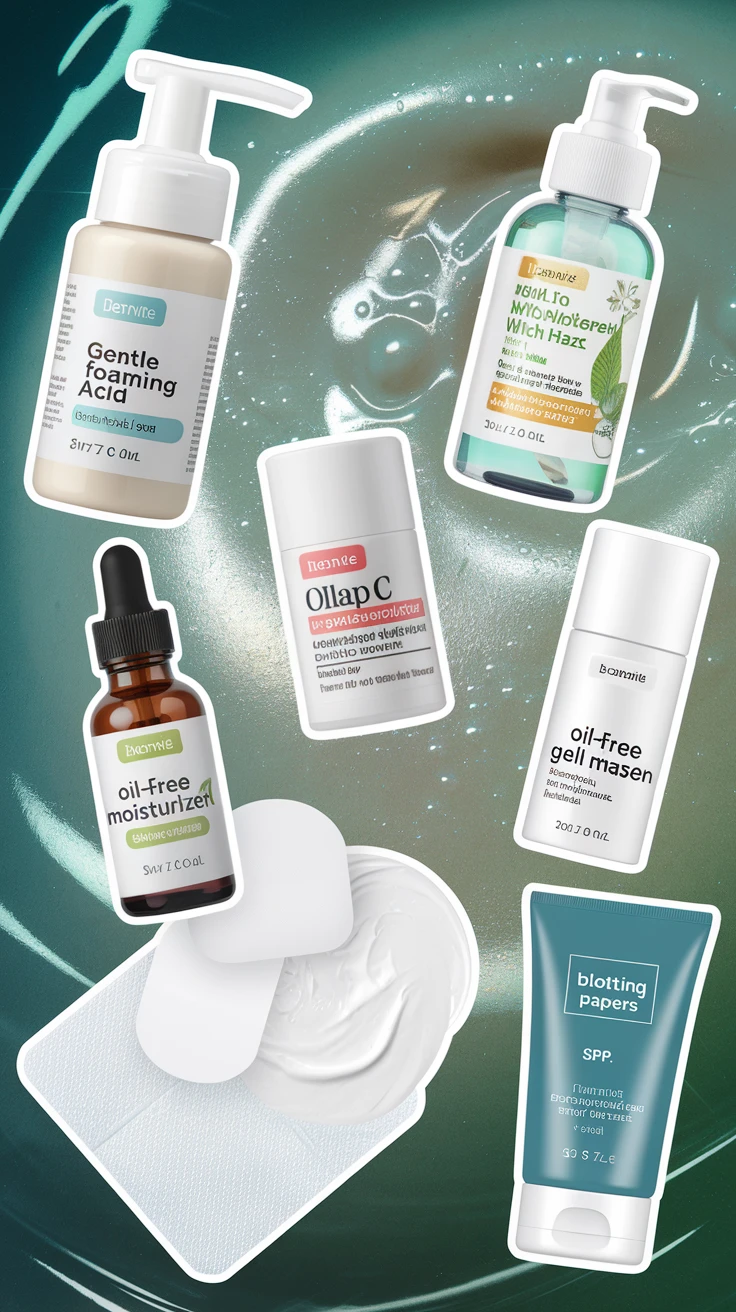
Managing oily skin is all about finding that perfect balance—controlling excess sebum without stripping the skin of its natural moisture. I’ve battled oily skin throughout my twenties, especially during humid summer months, and discovered that gentle yet effective products make all the difference in a daily skin care routine for this skin type.
- Look for products labeled “oil-free” or “non-comedogenic”
- Ingredients like salicylic acid, niacinamide, and tea tree oil can help control oil
- Lightweight, gel-based moisturizers provide hydration without heaviness
- Clay masks used 1-2 times weekly can help absorb excess oil
- Avoid harsh, alcohol-heavy products that can trigger more oil production
Morning Routine
- Cleanse with a gentle foaming cleanser containing salicylic acid
- Apply an alcohol-free toner with witch hazel or niacinamide
- Use a lightweight antioxidant serum (vitamin C works well for oily skin)
- Apply an oil-free, gel-based moisturizer
- Finish with a mattifying sunscreen (SPF 30 or higher)
Evening Routine
- Double cleanse (oil-based cleanser followed by water-based cleanser)
- Apply toner to rebalance pH
- Use a treatment with salicylic acid or retinol (start with lower concentrations)
- Apply a lightweight, oil-controlling moisturizer
The key to managing oily skin is consistency and moderation. Overwashing or using harsh products can actually trigger your skin to produce more oil as a defensive response. I’ve found that treating oily skin gently while using targeted active ingredients yields the best results in a daily skin care routine.

View on AmazonAs an Amazon Associate, I earn from qualifying purchases.

View on AmazonAs an Amazon Associate, I earn from qualifying purchases.
Pro tip: Keep oil-absorbing sheets in your bag for midday touch-ups. They’re a game-changer for controlling shine without disturbing your makeup or adding more product to your skin.
2. Daily Skin Care Routine for Dry Skin: Hydration and Protection
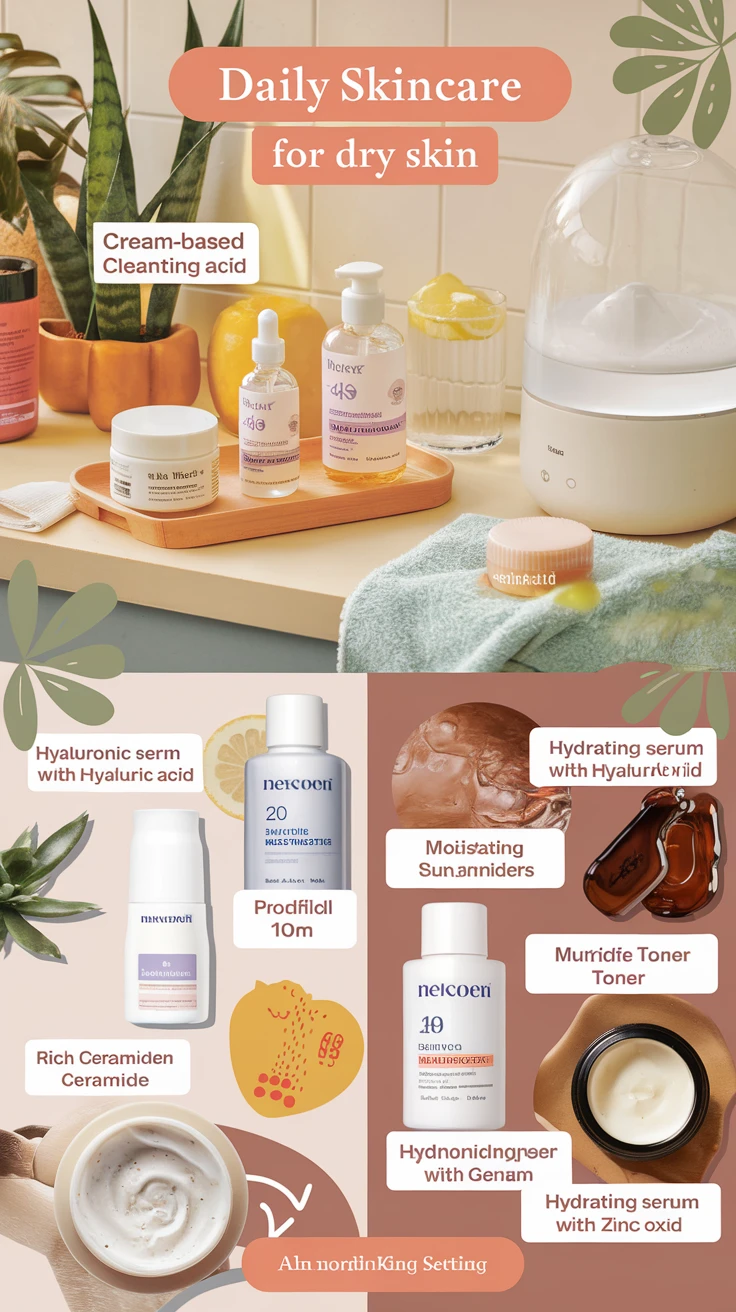
Dry skin craves consistent moisture and protection from elements that can further deplete hydration. After moving to a drier climate, my previously combination skin became increasingly parched, teaching me the importance of layering hydration in my daily skin care routine. The right approach can transform flaky, tight skin into a smooth, comfortable complexion.
- Look for ingredients like hyaluronic acid, glycerin, ceramides, and squalane
- Cream or oil-based cleansers preserve natural oils
- Avoid hot water, which can strip moisture from the skin
- Consider using a humidifier in your bedroom
- Heavier moisturizers and facial oils can provide lasting hydration
Morning Routine
- Cleanse with a cream-based, sulfate-free cleanser
- Apply a hydrating toner or essence with hyaluronic acid
- Use a moisturizing serum with multiple molecular weights of hyaluronic acid
- Apply a rich moisturizer with ceramides
- Finish with a hydrating sunscreen (SPF 30 or higher)
Evening Routine
- Remove makeup with a cleansing balm or oil
- Cleanse with a gentle, hydrating cleanser
- Apply a hydrating toner
- Use a treatment serum (peptides or gentle retinol formulated for dry skin)
- Apply a rich night cream
- Consider adding a facial oil as a final step to seal in moisture
For extremely dry skin, incorporating weekly hydrating masks and overnight treatments can provide additional relief. I’ve found that applying moisturizer to slightly damp skin helps lock in hydration more effectively. Remember that hydration needs to come from both inside and out, so drinking plenty of water complements your external daily skin care routine.

View on AmazonAs an Amazon Associate, I earn from qualifying purchases.

View on AmazonAs an Amazon Associate, I earn from qualifying purchases.
Pro tip: Keep a hydrating face mist in your bag for midday moisture boosts. Look for ones containing glycerin or hyaluronic acid rather than just water, which can actually increase dryness as it evaporates.
3. Daily Skin Care Routine for Sensitive Skin: Gentle and Soothing
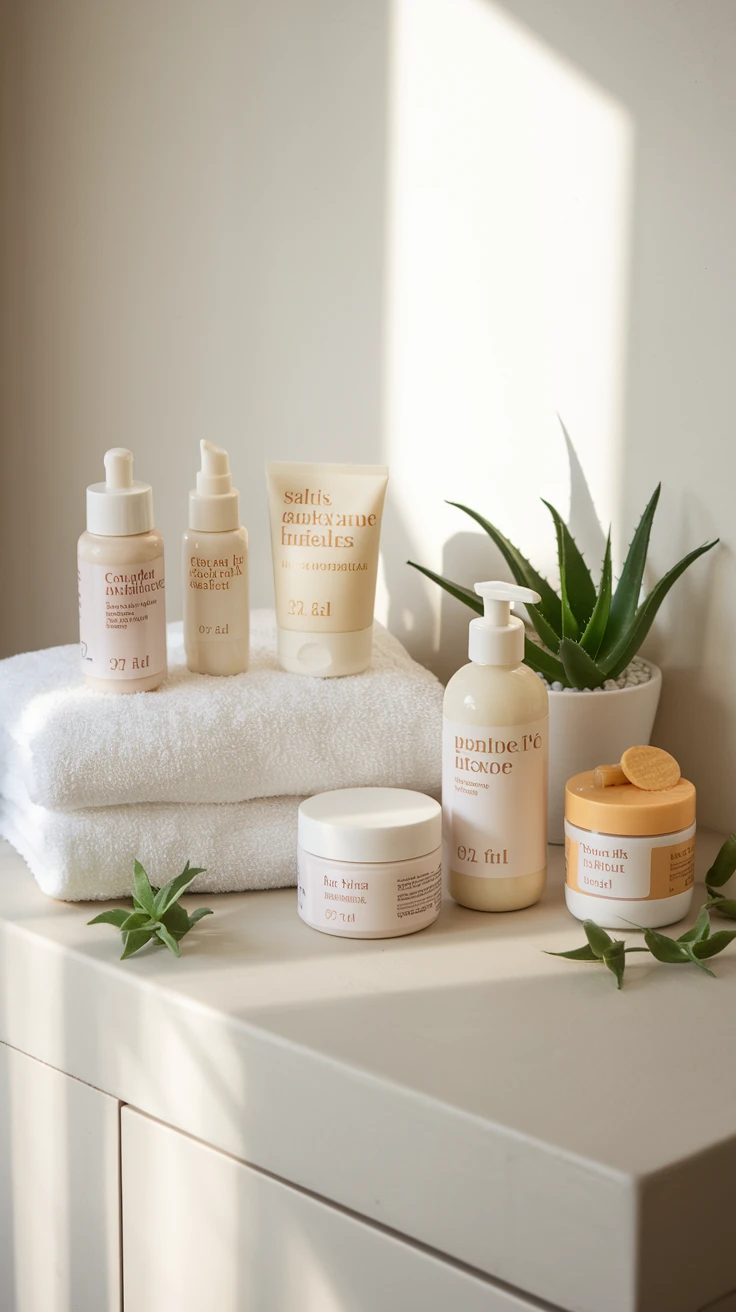
Sensitive skin requires a thoughtful, minimalist approach to avoid triggering reactions while still providing essential care. I developed sensitivity after an aggressive treatment several years ago, and it taught me the value of a gentle daily skin care routine. The goal is to strengthen your skin barrier while avoiding common irritants.
- Look for fragrance-free, dye-free products with minimal ingredients
- Soothing ingredients like centella asiatica, aloe vera, and oat extract can calm irritation
- Physical/mineral sunscreens (zinc oxide, titanium dioxide) are typically better tolerated than chemical ones
- Patch test every new product before adding it to your routine
- Introduce only one new product at a time, waiting at least a week between additions
Morning Routine
- Cleanse with lukewarm water or a gentle, sulfate-free cleanser
- Apply a soothing toner with minimal ingredients (optional)
- Use a simple moisturizer with barrier-supporting ingredients
- Finish with a mineral-based sunscreen (SPF 30 or higher)
Evening Routine
- Remove makeup with a gentle micellar water or cleansing oil
- Cleanse with a mild, fragrance-free cleanser
- Apply a soothing serum with centella asiatica or madecassoside (optional)
- Use a simple, fragrance-free moisturizer
When dealing with sensitive skin, less is often more. I’ve learned to be patient with my skin and to resist the urge to try every new product on the market. Building a consistent, gentle daily skin care routine with trusted products has been far more beneficial than constantly introducing new formulations. Remember that even natural ingredients can cause reactions in sensitive skin.

View on AmazonAs an Amazon Associate, I earn from qualifying purchases.

View on AmazonAs an Amazon Associate, I earn from qualifying purchases.
Pro tip: Keep a skin diary to track reactions and identify potential triggers. Note environmental factors (weather, stress, diet) alongside products used to identify patterns that might not be immediately obvious.
4. Daily Skin Care Routine for Combination Skin: Strategic Application
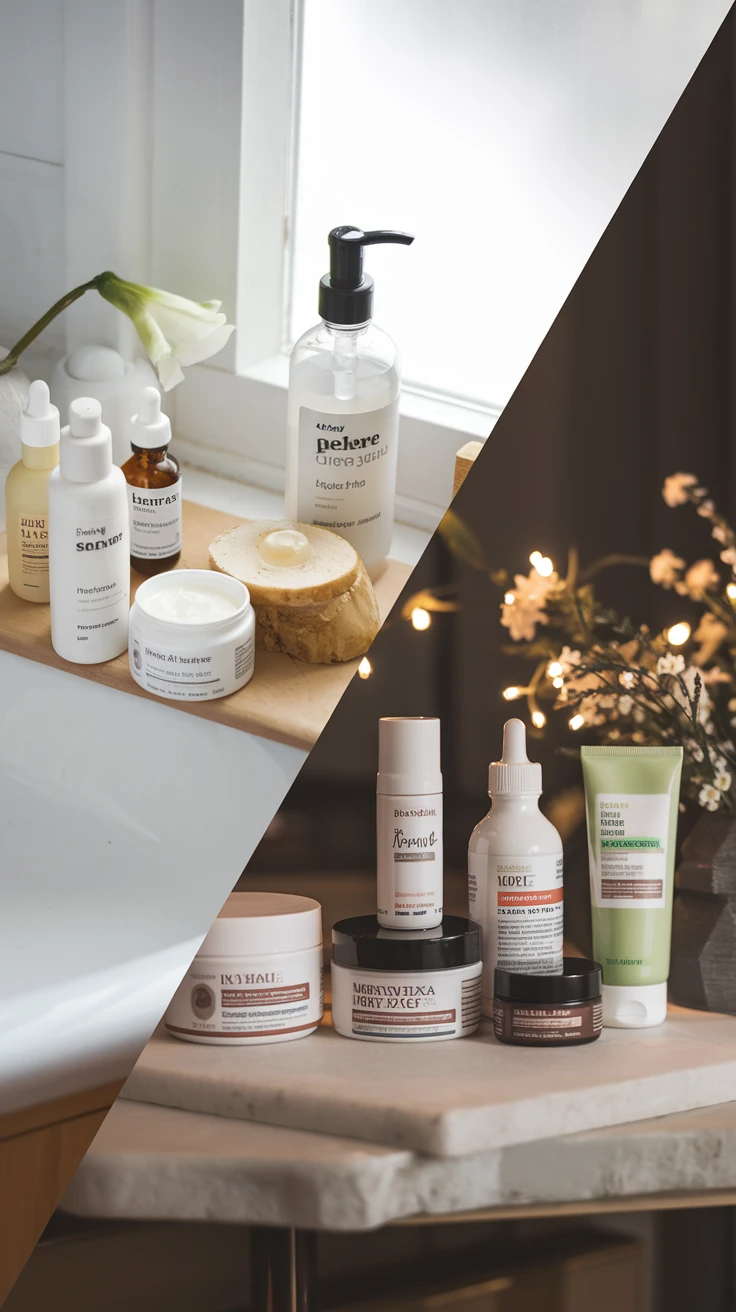
Combination skin presents a unique challenge, requiring different approaches for different areas of the face. With an oily T-zone and dry cheeks myself, I’ve perfected the art of targeted application in my daily skin care routine. The key is using the right products in the right places while maintaining overall balance.
- Consider using different products on different areas (heavier moisturizer on cheeks, lighter gel on T-zone)
- Look for balanced formulations with ingredients like niacinamide that help regulate oil
- Multi-masking (applying different masks to different areas) can address multiple concerns
- Layerable, lightweight products allow for customized hydration levels
- Gentle exfoliation helps maintain balance across different zones
Morning Routine
- Cleanse with a gentle, balanced pH cleanser
- Apply a balancing toner containing niacinamide
- Use a lightweight, hydrating serum all over
- Apply a gel moisturizer to oilier areas and a richer cream to drier areas
- Finish with a sunscreen that has a natural or semi-matte finish
Evening Routine
- Double cleanse to remove makeup and impurities
- Apply a balancing toner
- Use a treatment product (mild retinol or AHA/BHA serum)
- Apply moisturizer strategically – lighter on oily areas, richer on dry areas
- Consider spot treating specific concerns (hydrating serum on dry patches, salicylic acid on breakouts)
The beauty of having combination skin is that you can customize your daily skin care routine to address multiple concerns simultaneously. I’ve found that seasonal adjustments are particularly important with combination skin—what works in humid summer months may leave my cheeks feeling parched in winter. Being attentive to how your skin responds and adjusting accordingly is key.

View on AmazonAs an Amazon Associate, I earn from qualifying purchases.

View on AmazonAs an Amazon Associate, I earn from qualifying purchases.
Pro tip: For special occasions when you need your skin to look its best, use a clay mask on just your T-zone and a hydrating mask on your cheeks the night before. This targeted approach addresses both concerns without compromising either area.
5. Daily Skin Care Routine for Aging Skin: Prevention and Repair
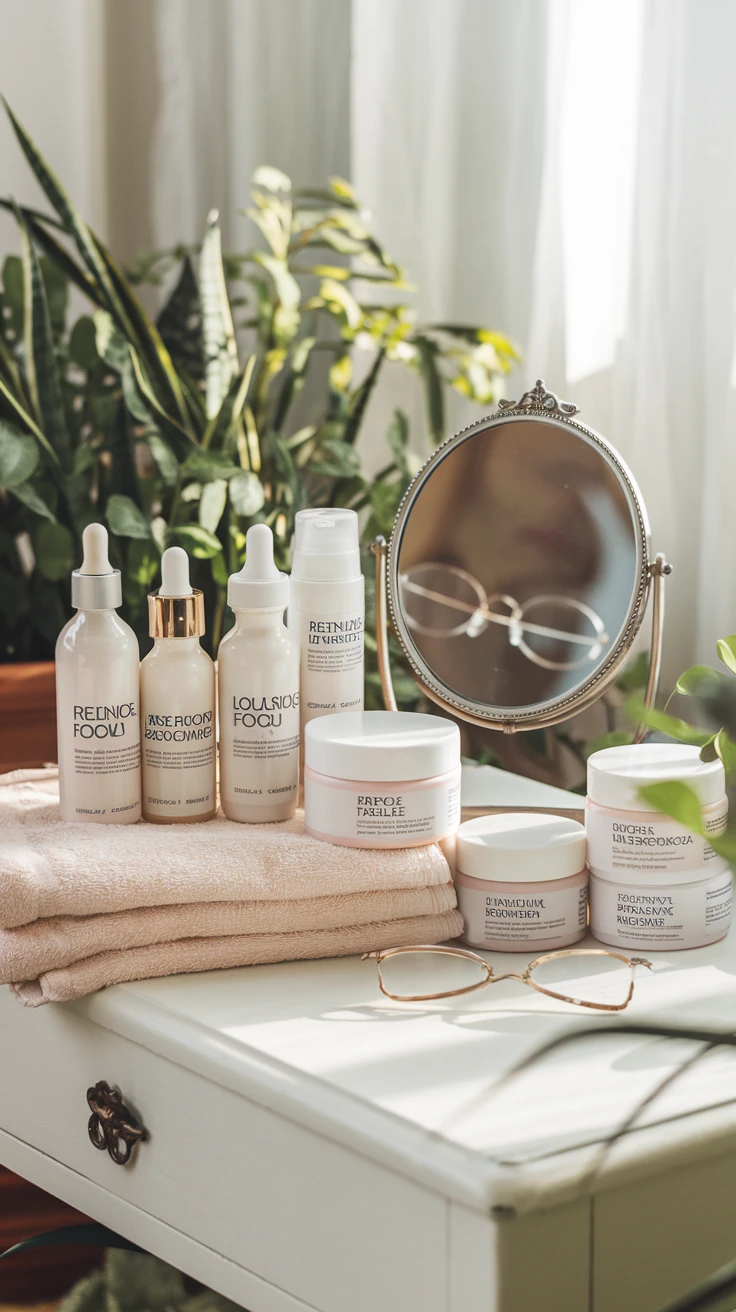
Aging skin benefits from a comprehensive approach that addresses multiple concerns: fine lines, loss of firmness, uneven tone, and increased dryness. As I’ve entered my forties, I’ve refined my daily skin care routine to include both preventative and reparative elements. The right combination of ingredients can make a remarkable difference in skin’s appearance and resilience.
- Prioritize ingredients like retinoids, peptides, antioxidants, and growth factors
- Increased focus on sunscreen and antioxidant protection is essential
- Gentler exfoliation helps cell turnover without causing irritation
- Richer moisturizers support the skin’s natural barrier function
- Eye-specific products address the delicate skin in this area
Morning Routine
- Cleanse with a gentle, hydrating cleanser
- Apply an antioxidant serum (vitamin C is excellent for aging skin)
- Use an eye cream with peptides and caffeine
- Apply a moisturizer with peptides and niacinamide
- Finish with a broad-spectrum sunscreen (SPF 30-50)
Evening Routine
- Double cleanse to thoroughly remove sunscreen and makeup
- Apply a hydrating toner or essence
- Use a retinol/retinoid product (start with lower concentrations and build tolerance)
- Apply a peptide or growth factor serum
- Use a richer night cream with ceramides and fatty acids
- Apply a specialized eye cream
Consistency is particularly important for aging skin. Results from ingredients like retinol take time to develop, so patience and persistence with your daily skin care routine will yield the best outcomes. I’ve found that treating aging skin isn’t just about addressing wrinkles—maintaining hydration, supporting the skin barrier, and protecting against environmental damage all contribute to a more youthful appearance.

View on AmazonAs an Amazon Associate, I earn from qualifying purchases.

View on AmazonAs an Amazon Associate, I earn from qualifying purchases.
Pro tip: Don’t forget your neck and décolletage in your anti-aging routine. These areas show signs of aging quickly but are often neglected. Extend all your facial products downward, and consider sleeping on your back to prevent “sleep wrinkles.”
Customizing Your Daily Skin Care Routine: Seasonal and Lifestyle Adjustments

A truly effective daily skin care routine evolves with your skin’s changing needs. Factors like seasonal changes, stress levels, hormonal fluctuations, and lifestyle shifts all impact your skin’s condition. Learning to make thoughtful adjustments has been one of the most valuable skills I’ve developed in my skin care journey.
- Winter often requires richer moisturizers and reduced exfoliation
- Summer may call for lighter formulations and increased sun protection
- Stress and lack of sleep can trigger inflammation and breakouts
- Hormonal fluctuations may require cyclical adjustments to your routine
- Travel, especially to different climates, often necessitates routine modifications
Pay attention to how your skin feels rather than automatically following a prescribed routine. If your skin feels tight, add more hydration regardless of your skin type. If you notice congestion, consider gentle exfoliation. The best daily skin care routine is responsive to your skin’s actual needs rather than rigidly following a formula.
Pro tip: Keep a “skin wardrobe” of products for different conditions rather than using the same products year-round. Just as you wouldn’t wear the same clothes in all seasons, your skin benefits from having options for different conditions.
Conclusion: Finding Your Perfect Daily Skin Care Routine
Creating an effective daily skin care routine is a personal journey of discovery. While these five customized routines provide solid frameworks, the perfect regimen is one that you adapt to your unique needs. Listen to your skin, be consistent with the basics (cleansing, moisturizing, and sun protection), and thoughtfully incorporate targeted treatments for your specific concerns.
Remember that even the most expensive products won’t work if you don’t use them consistently. A simple daily skin care routine that you follow faithfully will yield better results than an elaborate one that you can’t maintain. Start with the basics for your skin type, and gradually introduce new products one at a time to assess their impact.
Your skin is as unique as you are, and it deserves a daily skin care routine that honors its specific needs. With patience, observation, and the right products, you can develop a regimen that helps your skin look and feel its best at every stage of life.
Frequently Asked Questions About Daily Skin Care Routines
1. How long does it take to see results from a new daily skin care routine?
Minor improvements in hydration and texture can appear within days, but significant changes typically take 4-6 weeks, which is the average skin cell turnover period. For concerns like hyperpigmentation or fine lines, expect to wait 8-12 weeks to see noticeable improvement. Consistency is key to seeing results.
2. Is it necessary to use products from the same brand in my daily skin care routine?
No, it’s not necessary to use products from the same brand. What matters more is choosing products with complementary ingredients that address your specific concerns. Sometimes mixing brands allows you to get the best formulations for each step of your routine.
3. How many products do I really need in my daily skin care routine?
A basic effective routine can be as simple as a cleanser, moisturizer, and sunscreen. Additional products like toners, serums, and treatments can address specific concerns but aren’t always necessary. It’s better to have a consistent simple routine than an inconsistent complex one.
4. Should I change my daily skin care routine as I age?
Yes, skin needs typically change with age. Younger skin often focuses on oil control and acne prevention, while mature skin benefits from increased hydration and ingredients that address fine lines and loss of firmness. Reevaluate your routine every few years or when you notice significant changes in your skin.
5. Can I use the same daily skin care routine for morning and night?
While you can simplify, ideally your routines should differ slightly. Morning routines should focus on protection (antioxidants and sunscreen), while evening routines can emphasize repair and treatment (retinoids, exfoliants). Night is also when you can use richer products since you don’t need to worry about makeup application.


